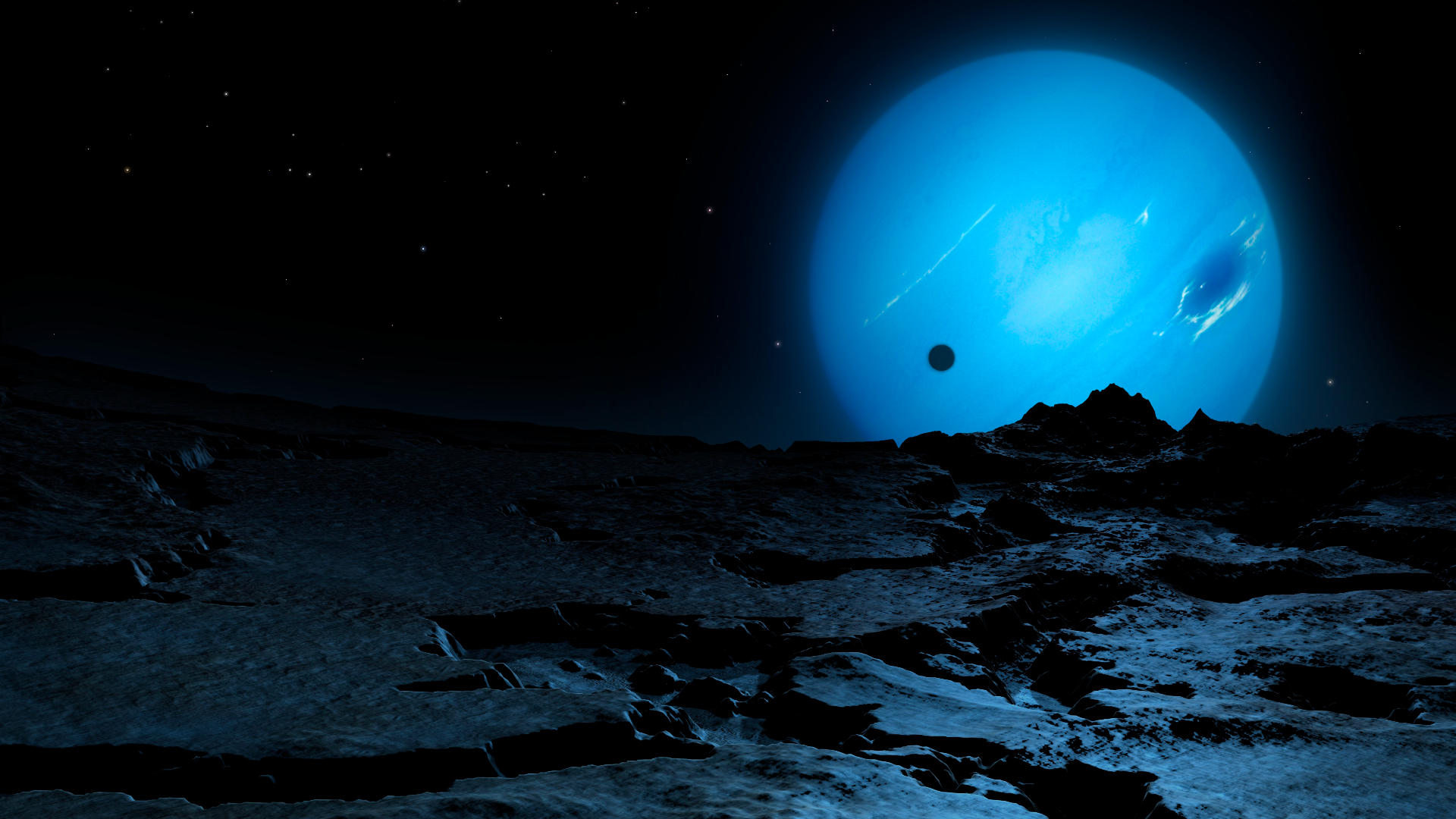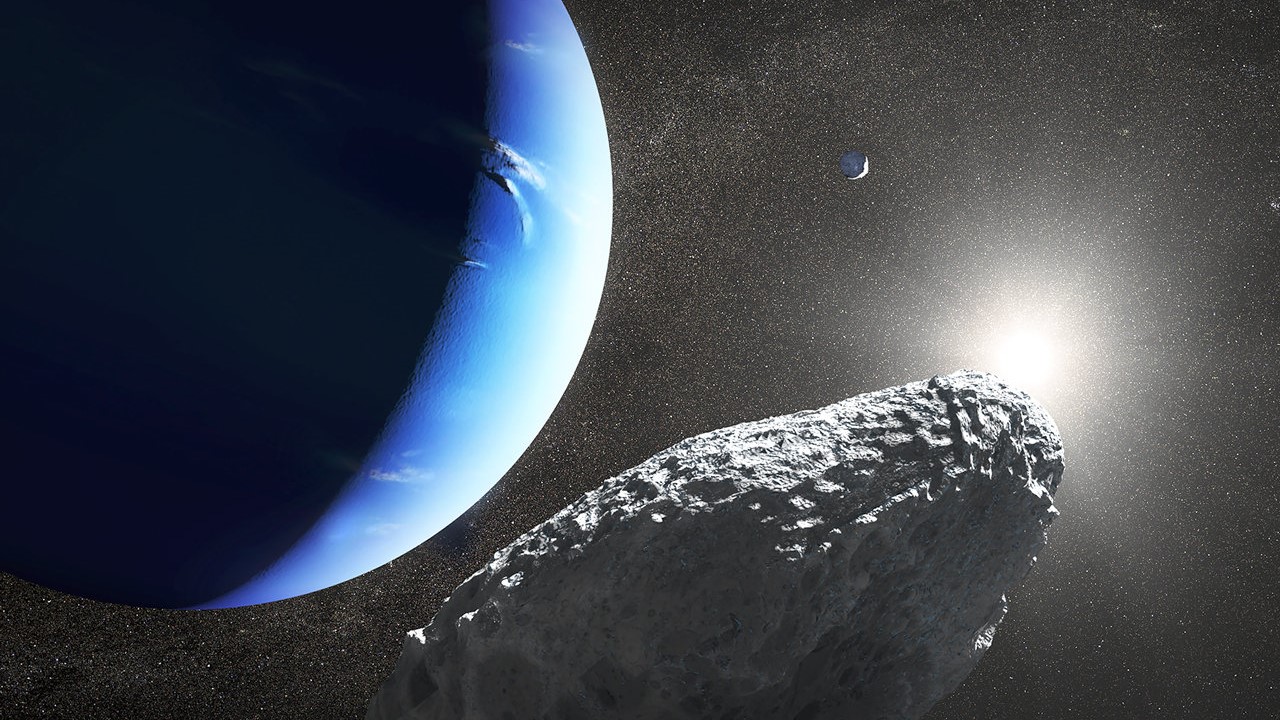Neptune moons: Facts about the elusive moons of the Neptunian system

Neptune has 16 moons, all named after various sea gods and nymphs in Greek mythology. All but two of Neptune's moons have been named.
Almost half of Neptune's moon discoveries occurred decades after NASA's Voyager 2 spacecraft swung past the planet and its system, demonstrating how far telescope technology has progressed.
The most recent Neptune moon discovery was announced in 2013. Scientists spotted the satellite — Hippocamp, originally designated S/2004 N 1 — after analyzing old images from the Hubble Space Telescope. The moon is tiny, said to be about 100 million times fainter than what the naked eye can spot in the night sky.
Related: The 10 weirdest moons in the solar system
Pre-Voyager 2 moon discoveries
Only two of Neptune's moons were discovered with ground telescopes before NASA's Voyager 2 probe visited the Neptunian system. The first, Triton, was discovered by British astronomer William Lassel in 1846, just 17 days after Neptune itself was discovered. The second moon to be discovered was Nereid when Dutch astronomer Gerard Kuiper spotted the small moon in 1949.
Voyager 2 moon discoveries
Voyager 2 flew through Neptune's system in August 1989 and found several satellites during its journey.
Astronomers did technically spot Larissa, a 60-mile (97-kilometer) moon, in 1981 with a ground telescope. But it wasn't confirmed until 1989 when the spacecraft was close by. Voyager 2's images showed an asteroid-like body with a surface pockmarked with craters. The moon's orbit is slowly moving closer to Neptune. Scientists believe it will either smack into the planet's atmosphere or break into a ring if tidal forces first rip the moon apart.
Breaking space news, the latest updates on rocket launches, skywatching events and more!
Proteus was a surprise find because it was so large: 130 miles (210 kilometers), bigger than the moon Nereid that was first spotted from Earth. Proteus, however, is much darker and could have eluded telescopic detection for that reason. The moon has a lumpy shape with many craters. If it was just a bit bigger, its gravity would pull the moon's shape closer to a sphere, NASA said.
Tiny Naiad — which looks a bit like a potato in shape — probably is a combination of fragments from several Neptune satellites, NASA said. The moon wasn't found by astronomers again until 2013 when scientists used a different technique on Hubble Space Telescope images to reduce Neptune's glare — making the moon far more visible.
Thalassa probably has a similar composition to Naiad, but the planet is disk-shaped despite its small size. Both moons also have orbits that will eventually fall into Neptune.
The spacecraft also found Galatea — which may have gravitational effects on Neptune's rings — and Despina, which is within the rings themselves.
Post-Voyager 2 discoveries
While there is no spacecraft currently en route to Neptune, telescope technology on the ground is improving with the aid of tools such as adaptive optics. There also are telescopes in space that don't have to fight through the Earth's atmosphere to see things. Both of these changes allowed many Neptune moon discoveries in the early 2000s.
Four moon discoveries were announced at once in 2002: Laomedeia, Halimede, Sao and Neso. These moons are so small and distant that little is known about them besides their orbits. Most probably were formed after collisions with stray rocks in the vicinity. The team that found them used the 4-meter Blanco telescope at the Cerro Tololo Inter-American Observatory in Chile, and the 3.6-meter Canada-France-Hawaii Telescope.
Psamathe was found just a year later using the 8.3-meter Subaru reflector at the Mauna Kea Observatory. Neso's and Psamathe's orbits are somewhat similar, but not much more is known about the moon besides that.
The last Neptunian moon found to date was announced in 2013. Scientists spotted the satellite — Hippocamp, originally designated S/2004 N 1 — when analyzing old Hubble Space Telescope images. It's just 12 miles (19 kilometers) in diameter.
Neptune's moon names and discovery dates
Here is a list of Neptune's 14 named moons and the dates of their discovery according to NASA.
Despina: Discovered in July 1989 by the Voyager 2 science team. Despina is a small, irregularly shaped moon that is located within Neptune's ring system.
Galatea: Discovered in July 1989 by the Voyager 2 science team. Galatea is a small and irregularly shaped moon.
Halimede: Discovered on Aug. 14, 2022, by Matthew J. Holman, John J. Kavelaars, Tommy Grav, Wesley C. Fraser, and Dan Milisavljevic using images taken by the 4.0-meter Blanco telescope at the Cerro Tololo Inter-American Observatory in Chile and the 3.6-meter Canada-France-Hawaii Telescope in Hawaii. Very little is known about Halimede. The tiny moon is about 100 million times fainter than can be seen with the unaided eye and was missed by Voyager 2. It orbits Neptune in the opposite direction of Neptune's rotation, known as a retrograde orbit.
Hippocamp: Discovered by Mark Showalter on July 1, 2013, during his analysis of old Hubble Space Telescope images taken of the Neptunian system between 2004 and 2009. The moon measures approximately 20 miles (34 kilometers) across, making it the smallest known moon of Neptune.
Laomedeia: Discovered Aug. 13, 2022, by Matthew J. Holman, John J. Kavelaars, Tommy Grav, Wesley C. Fraser, and Dan Milisavljevic using images taken by the 4.0-meter Blanco telescope at the Cerro Tololo Inter-American Observatory in Chile and the 3.6-meter Canada-France-Hawaii Telescope in Hawaii. The small, irregularly shaped moon orbits Neptune in a distant, eccentric orbit.
Larissa: Officially discovered in July 1989 by the Voyager 2 science team, Larissa was originally spotted by H. Reitsema, W. Hubbard, L. Lebofsky, and D. Tholen through ground-based telescopes in 1981. Larissa is a heavily cratered small moon with a mostly circular orbit that is slowly spiraling inward. The moon may eventually impact Neptune's atmosphere if it isn't torn apart by the gas giant's tidal forces first.
Naiad: Discovered by the Voyager 2 science team during the flyby in September 1989. The potato-shaped moon like Larissa has a decaying orbit, meaning it will eventually crash into Neptune's atmosphere or be torn apart by the tidal forces.
Nereid: Discovered on May 1, 1949, by Dutch astronomer Gerard P. Kuiper with a ground-based telescope. It is one of Neptune's outermost moons and is among the largest. It has the most eccentric orbit of any moon in the solar system.
Neso: Discovered in 2002 by Matthew J. Holman, John J. Kavelaars, Tommy Grav, Wesley C. Fraser, and Dan Milisavljevic using the 4-m Blanco telescope at Cerro Tololo Observatory in Chile. Little is known about the distant irregular Neptunian moon.
Proteus: Discovered in 1989 by the Voyager 2 science team, Proteus is one of the largest moons of Neptune. It is possible that Proteus eluded ground-based observations because it reflects only 6% of sunlight, making it one of the darkest objects in the solar system.
Psamathe: Discovered August 29, 2003, by Scott S. Sheppard, David C. Jewitt and Jan T. Kleyna sing the 8.3-m Subaru reflector at the Mauna Kea Observatory on the island of Hawaii. The small moon has one of the most distant orbits of any moon in the solar system, taking almost 26 Earth years to complete a single orbit of Neptune.
Sao: Discovered Aug. 14, 2002, by Tommy Grav, Matthew J. Holman, John J. Kavelaars, Wesley C. Fraser, and Dan Milisavljevic using images taken by the 4.0-m Blanco telescope at the Cerro Tololo Inter-American Observatory in Chile and the 3.6-m Canada-France-Hawaii Telescope in Hawaii. Sao is about 100 million times fainter than can be seen with the unaided eye.
Thalassa: Discovered in August 1989 by the Voyager 2 science team. Thalassa is an unusual disk-shaped moon.
Triton: Discovered on October 10, 1846, by British astronomer William Lassell, just 17 days after Neptune itself was discovered. Triton is Neptune's largest moon. It is rather unusual because it is the only large moon in the solar system that has a retrograde orbit — it orbits Neptune in the opposite direction of the planet's rotation. Scientists think that Triton was a Kuiper Belt Object that was captured by Neptune's gravity millions of years ago.
Additional resources
Learn more about Neptune's moons with the National Schools Observatory (NSO). Take a free course on the moons of our solar system with The Open University to expand your knowledge.
Bibliography
NASA Neptune Moon's, accessed Nov 28, 2022, from: https://solarsystem.nasa.gov/moons/neptune-moons/overview
Join our Space Forums to keep talking space on the latest missions, night sky and more! And if you have a news tip, correction or comment, let us know at: community@space.com.

Elizabeth Howell (she/her), Ph.D., was a staff writer in the spaceflight channel between 2022 and 2024 specializing in Canadian space news. She was contributing writer for Space.com for 10 years from 2012 to 2024. Elizabeth's reporting includes multiple exclusives with the White House, leading world coverage about a lost-and-found space tomato on the International Space Station, witnessing five human spaceflight launches on two continents, flying parabolic, working inside a spacesuit, and participating in a simulated Mars mission. Her latest book, "Why Am I Taller?" (ECW Press, 2022) is co-written with astronaut Dave Williams.


